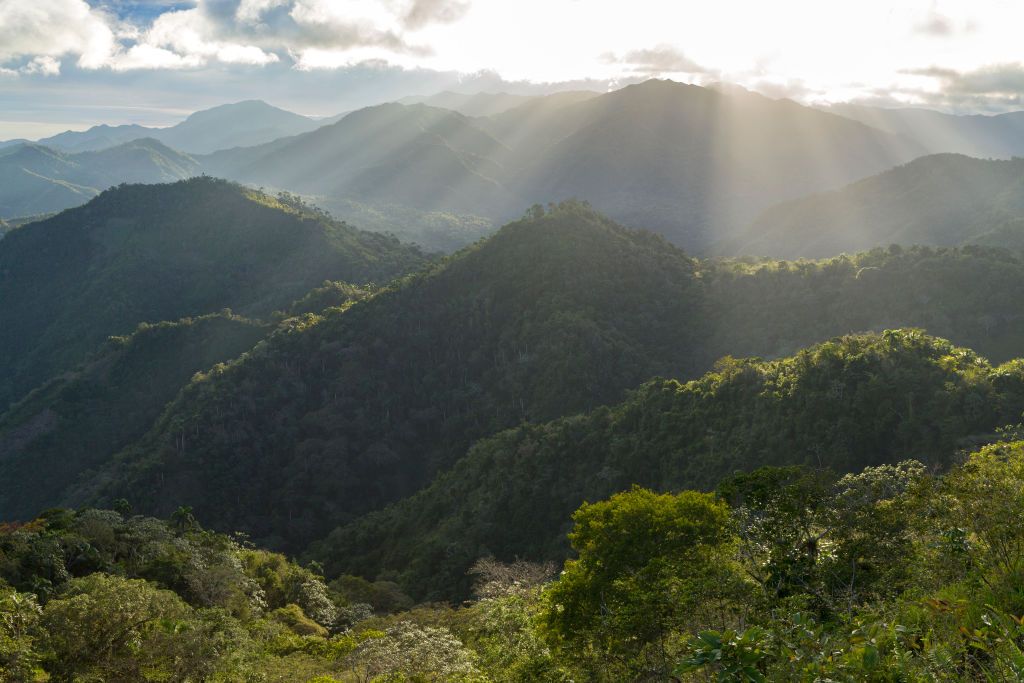Strawberry Fields Forever
The Guantanamo Bay detention facility, an atrocity, turns 20 years old on January 11. Living is easy with eyes closed, misunderstanding all you see.


Edited by Sam Thielman
THE FOREVER-WAR PRISON at Guantanamo Bay began operations on Jan. 11, 2002, and within two years, it got a bit of company. In September 2003, near the detention facility, the CIA began building a series of black sites. It was less a redundancy than an extension of logic.
The Pentagon, over these past 20 years, has typically insisted on distinctions between Guantanamo and the CIA's black sites. Officials point out that no one is known to have been waterboarded at Guantanamo; and now—though not in September 2003—Guantanamo detainees have access to legal counsel, for all the good that does the 39 men still there. Guantanamo Bay was, as well, an acknowledged prison, unlike the black sites—not that that did much good for all the people locked inside Guantanamo, whose identities the Pentagon hid for years.
But for all the Pentagon objections, the CIA's heritage runs throughout Guantanamo. The CIA's logic for the black sites was the military's logic for Guantanamo: a place beyond the reach of the law. Guantanamo's interrogation procedures—snarling dogs, sexual assault, sleep deprivation, etc.—were cassette dubs of stereophonically brutal CIA torture techniques. CIA medical personnel at the black sites kept detainees alive for another round of torture. Military medical personnel at Guantanamo administer force feedings that detainees describe as torture, all to keep detainees from embarrassing the United States by dying in captivity.
Most importantly, Guantanamo and the black sites imprison many of the same people—men like Majid Khan and Abu Zubaydah, for whom CIA captivity was relatively brief and military captivity relatively extensive. Early in the War on Terror, the CIA, fearful of exposure, wondered what would become of several of the people it tortured too extensively to release. For many, the answer has been Guantanamo.
CIA counterterrorism personnel liked to give their Guantanamo torture chambers cute names derived from Beatles songs, as if they weren't the cruel, ignorant servants of power that John Lennon hated. One of the black sites they called Penny Lane, and there they turned prisoners into assets. They called another one Strawberry Fields, the New York Times explained, "after CIA officials joked that the detainees would be held there, as the lyric put it, 'forever.'"
Guantanamo Bay began its incarnation as a forever prison 20 years ago Tuesday. It predated the CIA's black sites by months and outlasted them by over a decade. What is Guantanamo, if not the black sites persisting?
You’re reading a free post by Spencer Ackerman on FOREVER WARS, an independent outlet devoted to covering crimes of the state. We can’t make this work without support from our readers, and we want to keep on doing it as long as there are crimes to investigate (hence the title). Please consider signing up for a paid subscription using the button below.
ON SATURDAY, FOUR DAYS before the detention facility turned 20 years old, the War on Terror abolitionist group CAGE held a virtual forum for several survivors of Guantanamo.
There was Moazzam Begg, who has kept fighting against Guantanamo since his 2005 release, even as it has jeopardized his freedom. Seated beside Begg was Shaker Aamer, "the professor," a one-time hunger striker who looks healthy in his post-Guantanamo life. There was Omar Deghayes, tortured so badly in Guantanamo that he no longer sees out of his right eye. There was Mansour Adayfi and Mohamedou Ould Slahi, who wrote books about their imprisonment that made the world, however briefly, take notice. There was Ahmed Errachidi, the London cook whom Joint Task Force-Guantanamo called "the general."
And there was Omar Khadr, also blind in one eye, the most awful story of all—Guantanamo's Child, the 15-year old boy who grew to manhood being tortured in American cages. Begg joked that the seven of them were "the stars of Guantanamo," but when he welcomed Khadr, the humor left his voice. "Your journey…is probably the hardest one," Aamer told Khadr.
They assembled to remind people that 39 men are still locked inside Guantanamo as you read this. However solemn the task, there was also a sense of the sort of joy and peace found only among people who survive the same crucible. They laughed together. Most often, they expressed their anger or bitterness by mocking an injustice whose absurdity comes into clearer focus the longer it persists. Errachidi explained that the guards called him the "general" not because of any terrorist exploit, but because he kept a hunger strike he organized going for an extra two days after they took his comrade Deghayes into solitary.
"Ahmed, mashallah, he was mostly into resisting physically," Aamer remembered. "For my side, I tried to reach them." Aamer, who as a young man translated for the U.S. military in Saudi Arabia, would talk to the guards as human beings. As everyone who has covered the young guards at Guantanamo knows, some of them did know it was wrong, and responded by quietly doing what they could to make the detainees' lives easier. That's how they came to call Aamer "the professor."
Beneath the humor was a message. The men inside Guantanamo resisted. They did not passively accept their fate. Hunger striking was an attempt to take back a stolen life. Every journalist who has come through Guantanamo has heard Joint Task Force personnel talk about the cocktails of bodily fluids the detainees fling at their captors. Far more obscure are the ways that people like Errachidi and Aamer strengthened the spirits of those locked up with them. One of the task force's detention chiefs over the past 20 years, Col. Mike Bumgarner, once said that walking through the cell blocks with Aamer "was like I was with Bon Jovi or something." Aamer said the Americans couldn't seem to understand why men in cages would rush to kiss the hand of someone who went weeks without eating. "Everybody who resisted, who fought back, had to pay a very heavy price," he reflected.
It would take too long to detail the ordeal of Omar Khadr. You should read my friend Michelle Shephard's book, or watch her documentary. In 2015, when Khadr appealed his post-Guantanamo imprisonment in Canada, I flew to Edmonton and was on the spot when he was put into home monitoring at his attorney's house. All throughout Khadr's captivity, Canadian reactionaries and government functionaries assured that he would be dangerous if Khadr—a boy whom the Guantanamo guards once used as a human mop to soak up urine—went free. Six and a half years later, listening to this gentle man who has survived so much only underscored what vicious hysteria 9/11 unleashed, justified and normalized.
When it was his turn to speak, Khadr talked about how growing up in prison enabled him to discover himself, and to discover Islam for himself. (Left unsaid was that Khadr's parents, who were al-Qaeda supporters, took him to Afghanistan with them and turned him into a child soldier.) "Before I went to Guantanamo, I had an inferiority complex toward the west. That was very deep in me, maybe because we were living in hardship in Afghanistan," he said.
He continued: "I look at Guantanamo 20 years later, and I see the targets were people who had identity, and [the War on Terror] was to steal their identity, to break them, to make them ashamed of who we are, not understanding that putting us in that place together" could do the opposite.
Khadr had a parallel in mind. "I came back to Canada, I was released on bail, and one of the bail conditions was that I was not allowed to speak my mother tongue, to speak Arabic, with my family," he said. "The last time that happened was with the aboriginals."
"AROUND THE WORLD," write Letta Tayler and Elisa Epstein, "Guantánamo remains one of the most enduring symbols of the injustice, abuse, and disregard for the rule of law that the U.S. unleashed in response to the 9/11 attacks."
That's from a good overview/refresher of the infamy of Guantanamo, written for the prison’s 20th anniversary as a joint project of Human Rights Watch and the Costs of War Project. There's too much there to summarize, but one of the themes Tayler and Epstein emphasize is that closing Guantanamo has sunk to the bottom of the Biden administration's priorities list.
Below, I hope I don’t come across as critical of the authors. But that line, about Guantanamo as a maculate "symbol," draws my eye. It's a talking point you frequently encounter in anti-Guantanamo circles, and it's always rubbed me the wrong way. This paper is merely the most recent place I’ve read it.
Lamenting the symbolism of Guantanamo Bay is something of a social compromise. For twenty years, it’s been considered sophisticated political messaging. More Americans are likely swayed by appeals to the reputation of America than they are by exhortations to either try a piece of shit like like Khalid Sheikh Muhammad in a non-kangaroo court or free him. But if those appeals had worked, we wouldn't be here discussing the twentieth anniversary of Guantanamo. (Again, this isn't a criticism of Tayler and Epstein, who I do not believe use this phrase this way.)
The evil of Guantanamo isn't symbolic. It's an urgent, ongoing threat to the people locked inside. Beyond those people, Guantanamo is a sword of Damocles every day it remains open. An America in democratic crisis is one that will easily embrace either refilling Guantanamo or expanding indefinite detention throughout the criminal justice system. States of exception love a continuum.
Omar Deghayes on Saturday discussed Guantanamo less as a symbol than as a geopolitical precedent for the cheapness of Muslim life globally, from China to India to Egypt. "Because of Guantanamo, China was able to do what it does against the Muslims. They use the same argument, the same analogy: 'These Muslims are bad, they're extreme, they should be put into camps,'" Deghayes said. Before you get mad, recall that leaked documents show Chinese officials explicitly modeling their repression of Xinjiang on the War on Terror. "It's like Robben Island in Apartheid South Africa," he continued, "it needs to be closed down." (May the memory of the Archbishop Desmond Tutu, who spoke out against Guantanamo as he did against apartheid, be a blessing.)
But it would be tendentious to deny that Guantanamo does indeed exist also on the level of symbolism. The unfortunate truth is that it is an appropriate symbol. It symbolizes an America that not only lacks moral authority but deserves none. A country with moral authority would never have constructed Guantanamo. It would not have armies of lawyers to defend each of its operations, in design as in sustainment, lawyers who agree to litigate keeping men in cages beyond the reach of the law instead of resigning from the task in disgust. A country with moral authority would not have legal precedent for indefinite detention to draw upon for Guantanamo. It would not have mass movements that fantasize about locking their political opponents inside Guantanamo. It would not have stolen Guantanamo Bay from Cuba in the first place.
Begg, CAGE and their allies have presented Biden with an eight-point set of principles for closing Guantanamo. No one should be under the illusion that Biden will close Guantanamo absent enormous, unignorable pressure. For certain Swamp and Blob people I've encountered, the closure of Guantanamo is such a settled issue intellectually—obviously there should be no Guantanamo Bay, etc., but—that they neglect the task of actually closing it. That is one way for Strawberry Fields to remain forever.
Guantanamo will not vanish in a puff of logic. Its locks must be broken. Whenever that happens, if it happens, I suspect the teachers of the future who describe Guantanamo Bay truthfully will find their jobs in danger.
I'VE BEEN LOOKING BACK on some things I've written about Guantanamo over the years. Not really a healthy exercise, because when I read my old stuff, I tend to fixate on all the failures of reporting, imagination, critique, structure and prose. (You can imagine what it was like to take everything I've ever reported and turn it into REIGN OF TERROR; and to do half of that in the first year of the pandemic.) But this is a piece I did for the Awl in 2009 about going shopping at Guantanamo. I wouldn't write it the same way today but I don't hate it. I was 29 when I wrote this and I'm 41 looking back on it. Then I was just Kovacs, Kovacs pretending to be Rorschach.
Something I've never quite been able to capture in my journalism is that Guantanamo Bay is one of the most beautiful places on earth I've ever visited. At sunrise and sunset, the cliffs overlooking the Antilles present a purple-and-orange horizon I can only describe as majestic. The sand of the beaches is fluffy. The water is perfect in the baking heat. A place of natural sublimity is the scene of human obscenity.
Yes, I have swum in Guantanamo Bay. There are many manipulations of journalism imposed by the military there, to include outright censorship of your still and video imagery, but the subtlest is that the military helps you have fun. There are van shuttles to the Irish pub, buffets at the officers' club—which is right on those cliffs so you see the sunset at dinner—and opportunities to bike, go to the gym or, at times, swim.
The evident assumption is that if reporters enjoy themselves at Guantanamo, at least somewhat, they won't write the truth about its evil so forcefully. I can name several reporters who don't fall into that trap: Michelle, Carol Rosenberg now of the Times, Muna Shikaki of al-Arabiya, Ben Fox of the Associated Press. Maybe I can be like them one day.

